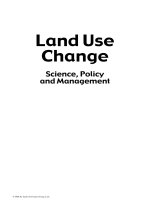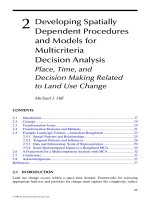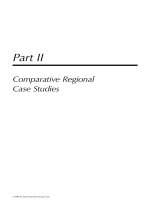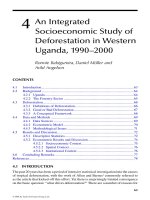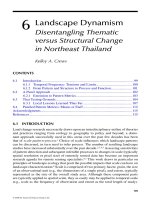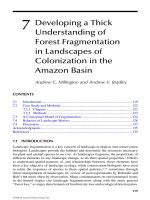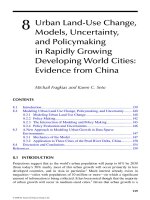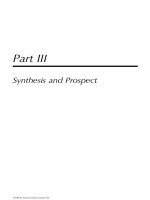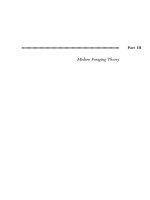Land Use Change: Science, Policy and Management - Chapter 8 doc
Bạn đang xem bản rút gọn của tài liệu. Xem và tải ngay bản đầy đủ của tài liệu tại đây (1.09 MB, 22 trang )
139
8
Urban Land-Use Change,
Models, Uncertainty,
and Policymaking
in Rapidly Growing
Developing World Cities:
Evidence from China
Michail Fragkias and Karen C. Seto
CONTENTS
8.1 Introduction 139
8.2 Modeling Urban Land Use Change, Policymaking, and Uncertainty 140
8.2.1 Modeling Urban Land Use Change 140
8.2.2 Policy Making 142
8.2.3 The Intersection of Modeling and Policy Making 143
8.2.4 Policy Evaluation and Uncertainties 146
8.3 ANewApproachinModelingUrbanGrowthinDataSparse
Environments 147
8.3.1 Mechanics of the Model 147
8.3.2 Application to Three Cities of the Pearl River Delta, China 150
8.4 Discussion and Conclusions 154
References 159
8.1 INTRODUCTION
Projectionssuggestthatastheworld’surbanpopulationwilljumpto61%by2030
(fromtoday’s50%mark),mostofthisurbangrowthwilloccurprimarilyinless
developed countries, and in Asia in particular.
1
Much interest already exists in
megacities—cities with populations of 10 million or more—on which a signicant
amountofinformationisbeingcollected.Ithasbeennotedthoughthatthemajority
ofurbangrowthwilloccurinmedium-sizedcities.
2
Given that urban growth is a
© 2008 by Taylor & Francis Group, LLC
140 Land Use Change
major component of global environmental change
3,4
andthedangerofpotential
undesirable environmental and social effects caused by high rates of growth is ever-
present, the relative importance of studying medium-sized cities versus megacities
cities in the next century is high. Furthermore, developing world cities have limited
humanandnancialresourcesemployedinvariousaspectsofpolicymaking.Con
-
sequently,thecollectionofreliabledataandtheuseofmoreadvancedmethodsin
planning practice and policymaking becomes extremely difcult (Figure 8.1).
Policymakers in developing world cities are increasingly faced with pressure to
assess the impact of their land use strategies and policies
5
as high population growth
trendsarepredictedforatleastthenext25years.Potentialsocioeconomicand
environmental impacts of policies can be assessed with quantitative models. Given
thenumberandunderlyingmotivesofdifferentapproachestomodeling,policy
-
makers, especially those in developing world cities, could benet from assistance in
choosingthemostappropriatemodel.Iscurrenttechnologyormethodologyadvance
-
ment based on current and recent future realities of medium-sized developing world
cities? Pros and cons of different modeling approaches for land use policy making
need to be evaluated given the particularities of such cities (e.g., the problem of
incomplete and scarce information). The success of sustainable development efforts
relies signicantly on the identication of better (as accurate as possible) forecasting
schemes regarding rates and patterns of future urban development that also connect
better with the process of policy making. Thus, this chapter provides an inquiry into
questions and tradeoffs a policymaker faces when it comes to the choice of context-
specic suitable modeling tools and the establishment of guidelines assisting the
decision-making process.
The purpose of this chapter is threefold. First, it discusses issues of urban land
usechangemodelingandexplorestheintersectionoflandusemodelingwithurban
policy making at different scales in the context of developing world cities. Second,
it discusses the effects of uncertainties in the data sources, theories, and models
methods of addressing these issues. Third, it reviews a predictive model of rapid urban
transformationthatrelatesastandardmodelingtraditiontoanexplicituncertainty-
reducing policy-making framework using Chinese cities as a case study.
8.2 MODELING URBAN LAND USE CHANGE,
POLICYMAKING, AND UNCERTAINTY
8.2.1 MODELING URBAN LAND USE CHANGE
Urbanareas,andtheirformandfunction,havebeenstudiedinthecontextsofurban
planning, urban economics, urban geography, and urban sociology, much of which
are grounded in the spatial land use models of von Thünen.
6
Aneedforquantita-
tive answers regarding the effects of extent, rate of change, and patterns of global
urban land use change has led to the development of urban land use change models
(ULCM).AULCMisasimplicationofreality,anditssuccessliesinretainingthe
fundamentalcharacteristicsofthesystembysimplifyingrealityasmuchasneces
-
sary(butnotbeyondthat).Thoughtofasatool,aULCMtargets“usefulness”;unfor-
tunately,thiscapacityisnotalwayssuccinctlystatedordemonstrated.
© 2008 by Taylor & Francis Group, LLC
Urban Land-Use Change, Models, Uncertainty, and Policymaking
141
-180
-60
Robinson Projection
Central Meridian 0.00
Source: ESRI Data & Maps CD
Kilometers
0 1,450 2,500 5,500 8,700 11,600
Country Boundary
POPULATION
750000
–
1000000
1000001
–
3000000
3000001
–
5000000
5000001
–
10000000
10000001
–
23620000
Antarctic Circle
Tropic of Capricorn
Equator
Pacific Ocean
Tropic of Cancer
Indian Ocean
Pacific Ocean
Atlantic Ocean
–
180
–
160
–
140
–
120
–
100
–
80
–
60
–
40
–
20 0 20 40
60 80
100 120
140 160 180
–
160
–
140
–
120
–
100
–
80
–
60
–
40
–
20
–
60
–
40
–
20
20
40
60
80
0
–
40
–
20
20
40
60
80
0
0 20 40 60 80 100 120 140 160 180
Arctic Circle
FIGURE 8.1 (See color insert following p. 132.) Population distribution of the world’s urban agglomerations with 750,000 people or more
around year 2000.
© 2008 by Taylor & Francis Group, LLC
142 Land Use Change
Theusefulnessofanurbanlandusechangemodelisjudgedinconnectiontothe
goal of the modeling exercise; these goals can be tightly or loosely connected with
goalsofpolicymakers.InthischapterwediscusstwodistinctfunctionsforaULCM:
explanation and prediction/forecasting (that leads to prescription). In its rst func
-
tion,ithelpstheresearcherorthepolicymakerimprovehisorherunderstandingof
processes that lead to change and shed light on elements of causality guided by and
testingalternativetheoriesofurbangrowth.Initssecondfunction,itcandescribe
and predict the types of land use change that occur (type, amount, rate, pattern, and
timing of changes) and more promptly lead to prescription.
Therearenowdozensoflandusemodelsavailable;areviewandtypologyof
(urban) land use change models has been presented in detail elsewhere.
7,8,9,10
Many
new “avors” of modeling are being developed.
11,12
This proliferation reects the
methodological progress in the attempt to understand or predict the nature of the
landscape, the types of changes occurring, the causal structure connecting the
underlying factors of change, and the hypotheses to be tested. Alternative classica
-
tionsofurbanlandusechangemodelsincludeathree-dimensionalcontinuumof
spatial scale, time scale, and human decision-making,
11
overlapping categories of
equation-based system, statistical technique, expert, evolutionary, cellular, hybrid,
and agent-based,
13
and distinct categories of large-scale, rule-based, state-change,
andcellularautomata.
14
ULCMsoftenclaimpolicyrelevancebutlackacleardenitionofthedegreeof
this relevance. Land use change modeling is currently weakly coupled with land use
policymaking.Althoughwedonotclaimaneedforaverystrongcoupling(dueto
theadverseresourceandpoliticalrealityforsuchataskindevelopingcountries),
wesuggestthatitneedstobestrengthenedforoptimalknowledgeutilizationinthe
policy-making process. This can be achieved by explicitly introducing mechanisms
formodeluncertaintyreductionandapolicy-makingmoduleinlandusechange
models. It is very important that the relevance of models is more clearly understood
andfuturedirectionsreevaluated.Inwhatfollows,weaddressissuesexistingatthe
modeling–policy-making interface.
8.2.2 POLICY MAKING
Policy-relevant land use change models may target a variety of types, levels, and
stages of policy-making activity that heavily inuences observed land use patterns.
Some facets of urban land use change derive in part from policies implemented
(synchronously or asynchronously) at different administrative unit levels: at local
municipal, county, state, prefecture, and regional levels. National macroeconomic,
regional,andlocalpolicieshavedramaticdirectandindirecteffectsonagents’
choices of current and future land use. Policymakers at these levels include a range
of public ofcials, such as urban and environmental planners, and various adminis
-
trators at local government agencies.
At the local and national levels, concerns regarding social welfare measured in
levels of consumption, productive activity, city amenities and disamenities, exter
-
nalities and ideas of sustainability guide policy-making efforts in targeting—among
othergoals—an“optimal”urbanareasize,shape,andpopulationmix.Localurban
© 2008 by Taylor & Francis Group, LLC
Urban Land-Use Change, Models, Uncertainty, and Policymaking 143
andexurbangovernmentsconsistentlyutilizezoning,growthcontrols,andtaxation/
subsidiestodriveurbangrowthandregulate,distribute,orredistributegainsfrom
urban development (while implicitly targeting that the maximization of property
values in urban areas). Increasingly, environmental concerns regarding the impact of
urbanlanduseconversionsalsodirectpolicymaking.Atthegloballevel,institution
-
ally designed policies inuence processes of urban land use change in a multitude of
ways through the establishment of incentive schemes and structural adjustment pro
-
grams. Close monitoring of urban population trends suggests the heightened interest
of international nancial and other institutions (such as the United Nations and the
World Bank) that drive global change.
Many theories of policy formation exist, with different assumptions regarding
knowledge utilization within the formation process. Most urban growth models are
not usually explicit on their assumptions regarding the policy-making process; the
mostwidelyadoptedviewofthepolicy-makingprocessisthatoftherationallinear
processoragendasettingtheory.Aswithmosttechnicalanalysisenteringthepolicy
realm, the policy relevance of a land use model is of a more informational nature
rather than a concrete policy driver nature.
From the rational policymaker’s standpoint, the use of a land use change model
involvesasequenceofdecision-makingstepsandactionsthatrequires(i)theexami
-
nationofavailablemodelingoptions,(ii)thechoiceofmodelevaluationcriteriaand
their weights (depending on the preferences of the policymaker and the realities of
the policy-making setting), (iii) evaluating the model by the selected criteria, and
(iv) deriving the overall evaluation through the collection of individual weighed
criterion evaluations.
5
Criteriafortheselectionofamodelingprocessmayinclude
the emphasis on prediction versus explanation, the data sparseness or richness of
thepolicy-makingenvironment,levelsofuncertaintyinthequalityofthedata,the
emphasis on probabilistic versus heuristic/mechanical approaches, the exibility
of the model to alternative variable specications, the sophistication in accuracy
assessment (validation) of predictions, the need of deep versus basic understanding
ofthemodelingapproach,theneedforweakversusstrongcouplingofmodeling
with the process of policy making, the model’s capacity to inform about a variety
ofpolicy-makinggoalsandatdifferentlevelsofpolicymaking,andtheemphasis
on the theoretical foundation of the modeling approach. Several of these criteria are
discussedinmoredetailbelow.
8.2.3 THE INTERSECTION OF MODELING AND POLICY MAKING
Recently we have witnessed a scarcity of application of ULCMs for developing
worldcities.Thisreectsanunderestimationofthepotentialeffectsofurbangrowth
inLDCs,theproblematicnatureofempiricalworkinLDCs,alackofunderstanding
ofwhatcouldbethebestmodelingoptionavailabletoadecisionmakerinadevel-
opingworldcity,andadearthofapplicableULCMs.Throughourworkweargue
that present pressing predictive needs elevate the importance of statistical models
that utilize a minimal input scheme. Models with simple input requirements can nd
wider application in addressing current and future needs in these cities. Datasets in
LDCs are scarce and in many cases inexact due to institutional factors and limited
© 2008 by Taylor & Francis Group, LLC
144 Land Use Change
resources. A future increased allocation of resources toward the collection of
detailed georeferenced socioeconomic data by the governments of these countries
isnotcertain,andalthoughdataarebeingcollectedataninternationallevel,this
occursataveryslowpaceandataquiteaggregatedlevel.Furthermore,problematic
measurement can be catastrophic for the predictive power of models that are suc
-
cessfulincapturingthetruedata-generatingprocess(DGP).
Understanding the importance of knowledge utilization in decision making,
thequestionoftherelativeimportanceofexplanationversuspredictionforpolicy
-
makersarises.Whendoesapolicymakerneed(i)predictionsregardingthelocation
andtimingoflandusechangeunderalternativescenariosand/or(ii)theknowledge
of whether theoretical hypotheses stand up to statistical tests and of magnitudes
oftheexpectedchangesassociatedwithshiftsinavarietyofpolicyleveragesand
viceversa?Itisnotclearifthepolicymakeralwaysneedsadeeperunderstanding
of processes and knowledge of the causation chain. Possibly, the answer to such a
question depends on the actual policy-making formation process and the type/level
of government or institution responsible for the decision. Various authors suggest
that, at a minimum, policymakers should be able to understand the foundations of a
modeling approach or at least be able to identify how the results are generated.
10,15
Given the number and level of complexities of alternative modeling approaches, this
may be an unrealistic target. Our experience with developing world cities shows that
policymakers are denitely more interested in knowing how shifts in policies affect
outcomes;theymaynotwanttoknowtheinnerworkingsofthemodel.
Policymaker preferences over output denes if and when the policymaker has
astakeinthechoiceofmethodology(e.g.,process-basedormechanisticmodels).
Although socioeconomic processes generate the observed landscape outcomes, models
that belong to a rule-based approach may in fact result in better predictions than pro
-
cess-basedmodelsutilizingsocioeconomicdata.Thiscanbepartlyattributedtodata
imperfection: variables capturing the socioeconomic processes can be inaccurate or
simply these processes might be hard or impossible to quantify. Mechanistic models
usedataconstructsthatarebasedonproximate(ratherthanunderlying)causesof
land use change. Unfortunately, these models are also more sensitive to omitted or
inexistentinformation,afactthatcanpotentiallymisguidepolicymaking.Process-
based models can still be successful to various degrees for forecasting, depending
on the geographical location, methods, and aerial unit level of analysis employed for
prediction. Such models with proven high predictive power are also usually based on
proximate rather than underlying causes. Naturally, successes in predictive capability
of rule-based models do not void the search for a DGP.
Models—as opposed to theories—of land use change theory have been more
populartoolsforpolicymakingandhavebeendevelopedmoreforbothsubstantive
and practical reasons.
10
Substantive reasons include the complexity of the land use
change phenomena and the complex interrelations of various institutional, cultural,
political, economic, and social change determinants in theoretical work. Practical
reasons include the availability of resources and the “demands of the of the decision
making ‘clientele’.” In short, solid quantitative results that are marketable, visually
© 2008 by Taylor & Francis Group, LLC
Urban Land-Use Change, Models, Uncertainty, and Policymaking 145
powerfulandreadyforuseastoolsforawiderangeofdecisionmakersarevalued
more highly—and models produce results much better than theory.
*
Established approaches in different scientic disciplines and pressures regard-
ing peer acceptance and career advancement also drive methodology-related choices
forurbanlandusechangemodelsandarepartlyresponsibleforlooseconnectionsof
models withpolicymaking.Theevidenceforthisisanecdotal,astheauthorshavebeen
exposedtosuchcomplaintsinpersonaldiscussionswithotherresearchers.Inshort,the
producer’s (an academic researcher) incentives for considerable output in the form of
journalpublicationsmayleadtomodelslooselyorvaguelyconnectedtothepracticeof
policy making. This issue is admittedly difcult to resolve under the current practices.
Awarenessofthetheoreticalfoundationofanapproachmayalsobeimportantfor
thepolicymaker’schoice.Urbancellularautomata(CA)models,forexample,havea
theoretical grounding on ideas of cities as self-organized and emergent phenomena
in bottom-up complex systems and fail to capture urban growth in the top-down
political dimension. Unfortunately, these are still “largely abstract arguments.”
16
Even
cutting-edge advanced multiagent system CA (MAS/CA) simulating cities “at the ne
scaleusingcells,agents,andnetworks”arefornowfarfrombeingreadyforanyprac
-
tical use or “largely … pedagogic” value.
16
As the decision-making clientele of urban land use change models targets a vari-
ety of goals, a good model should accommodate such a variety. Policymakers care
fordifferentsizeadministrativeareasdependingonwhethertheyareemployedata
local,provincial,ornationallevel.Modelsshouldbeabletoaddressneedsofeach
level of decision making and distill results derived at the highest level to the lowest
level and vice versa. Connected to this issue is the capacity to address single or
multiple neighboring urban areas in the same model. Single urban metropolitan area
analysis is not inclusive of surrounding regional spatial dynamics (immigration and
out-migration ows, trade ows, and so forth), an important limitation since cities
areinterconnectednodeswithinanetworkofows,aswellascomponentsofasystem
of central (urban) places.
Whenmodelsareweaklyinformedbytheory,anadvantageofaULUCmodelis
its exibility in allowing the user to make decisions on model specication (although
thedangerofmodelselectioniseverpresent—thisisaddressedinthenextsection).
Current design of mechanical rule-based models shows some inexibility to alterna
-
tive specications, with a resulting “one size ts all”/“cookie-cutter” feel. Finally,
an important consideration is the limitations in spatial representations of alternative
scenarios imposed by the ULCM, assuming that quantiable information on poten
-
tial alternative directions in local, regional, or national policies can be provided.
Policies such as zoning or growth controls are the easiest to represent, while open
-
ness to in-migration or other economic information such as market conditions may
not be easily incorporated into models. Highly stylized (input-restricted) models
areonlyabletoincorporatepoliciesreectingroaddevelopmentand“off-limitsto
development”zoning;thisisalimitingfactorinthecapacityofthemodelstoinclude
other forms of policy making.
* Pre-1981 literature on the politics of model use in decision and policy making is reviewed in Briassoulis
10
(1999, chap. 5).
© 2008 by Taylor & Francis Group, LLC
146 Land Use Change
8.2.4 POLICY EVALUATION AND UNCERTAINTIES
Model and expert knowledge utilization targets the reduction in the uncertainty
of outcome predictions and the consequent effects of these outcomes. Statistical
decision theory provides quantitative tools for the reduction of uncertainty in
optimal policymaking.
17
Giventhatanyurbanpolicysimulationresultsaredepen-
dentonmodels,howisthe“best”modeldenedandhowisitchosenamong
allpossiblemodels?Amodelisasinglerepresentationofreality,and,although
statisticalcriteriacanbeusedtoidentifythe“best”one,itrepresentsjustoneof
many possible data generating processes; thus, model selection should be avoided.
Modelselectionhasbeencriticizedasbeingaweakbasisforpolicyevaluationand
derivation of future prescriptions; the search for a single best predictive model is
misguided when it comes to policy-relevant models. Robustness across models, on
theotherhand,isbeingadvancedforpolicy-relevantwork.Unfortunately,model
selectionignoresthefundamentaldimensionof“modeluncertainty,”butmethod
-
ologies for robustness of the policy prescription across alternative model specica-
tions can be alternatively utilized.
Methodologies addressing the issues of theory and model uncertainty are now
available for incorporation in policy-relevant research.
17,18
Uncertainty over compet-
ingtheoriesresultsfromuncertaintyaboutwhichtheoryofurbangrowthshould
beutilizedduetoinstitutionalandculturalfactorsaffectinglandmarketsindevel
-
oping countries or differing assumptions regarding agent decision making; it can
lead to models that are not well informed by theory. Model uncertainty results from
uncertainty over functional form specication for statistical models and is due to
subjective perceived relevance and endogeneity issues as well as the question of
appropriate spatial and time lags, proxy variables, and so forth. Incomplete knowl
-
edgeregardingthebestmodelofasystemshouldforcetheresearchertoexplorethe
sensitivity of modeling approaches to alternative specications.
18
This framework
partially solves the problems of subjectivity and ad hoc specications in uncertain
environments regarding the capacity of a variety of proxies to capture the effect of
variables entering the data generating process.
Anappliedstatisticalframeworkofpolicy-relevanturbangrowthmodeling
thataccountsformodeluncertaintymakesanexplicitreferencetoapolicymaker
(PM hereafter) who examines a set of urban–growth-related policies
P for admin-
istrative units (e.g., sub-city districts, cities, counties, provinces) through the selec
-
tionofasinglepolicy
p.
17,18
ThePMutilizesdatad about a metropolitan area’s
land-use and transportation systems (realizations of a process), and the choice is
conditionalonamodel
m of the urban economy (m can constitute alternative theories
andstatisticalspecications).ThePMminimizestheexpectedvalueofanobjective
(loss) function
l(p,R) where R is a the exogenous state of nature (not controlled by the
PM but affecting the inuence of p on the loss, l)
*
.
* ConsiderX,avectoroftargetedurbangrowthratesperadministrativeunitpertimeperioddened
bythePM.Differentpolicieswilldrivedifferentratesandpatternsofurbangrowth.Thedeviationof
these growth rates from the targeted growth rates can be expressed as a loss function. Each adminis-
trativeunitisweightedaccordingtothepreferencesofthePM.Theweightsareassignedaccordingto
theimportanceofconvergencetothetargetforeachadministrativeunit:thegreatertheimportanceof
meeting the target, the higher the weight
18
.
© 2008 by Taylor & Francis Group, LLC
Urban Land-Use Change, Models, Uncertainty, and Policymaking 147
Unknown exogenous factors that inuence land use decisions (the state of nature
inadecision-theoreticframework)suchasmonetaryorscalmacroeconomic
policies lead to the minimization of the expected value of the loss function by the
PM. Usually probabilities of the states of nature are conditioned on existing data and
selected models:
N(R|d,m). Accounting for model uncertainty, they are not condi-
tioned on
m since the PM understands that there is probably no “best” model for the
urban land use system. The probability density function (pdf) for
R, N(R|d), is assumed
conditional on the existing data
d only (and not on m). With a well-dened loss func-
tion and
pdf, the optimal policy is the one that minimizes the expected loss—the
solutiontotheoptimizationproblem.WethusarguethataULCMshouldgenerate
a probability distribution of estimates and predictions as well as their distribution
characteristics/propertiesforeachpixelforeachtimeofchange.Amathematical
formulationofthemodelcanbefoundinFragkiasandSeto
18
and Brock et al.
17
The
following section describes the workings of an urban growth model that takes into
account the above considerations.
8.3 A New Approach in Modeling Urban Growth in
Data Sparse Environments
8.3.1
MECHANICS OF THE MODEL
We present here an approach in land use change modeling that can explicitly evaluate
policies under uncertainties within a spatial socioeconomic environment by incorpo
-
rating a methodology that addresses issues of theory and specication uncertainty.
ThemodelproposedbyFragkiasandSeto
18
isahybridspatiallyexplicitmodelof
urbanlandusechangewithafoundationoneconomicandstatisticaldiscretechoice
models of land use change,
8
adjusted for use in data-sparse environments.
The model rst reads the input data available provided through remote sensing
analysisandothersourcesatadenedspatialresolution.Initscurrentimplementation
these are: urban/non-urban land-use maps, a transportation network, areas excluded
from development, and a central business district location. It processes this data pro
-
ducing new images/matrices such as new urban growth between examined years
(abinaryimagefromwhichweextractinformationonadependentvariable)anda
collectionofnewimagesfromwhichthemodelextractsindependentvariables.
*
Next, the model employs statistical analysis for the calibration stage. Separat-
ingthestudyareaintotwoparts(itsEastandWesthalf),itperformsarandom
samplingofdevelopablepixelsoftheinitialEasthalfoftheurban/non-urbanimage
(at time
t0).Itcreatesacalibrationdatasetwithasingledependentvariableandmulti-
plesetsofindependentvariablesreadyforregressionanalysis.Usingtwo(
t0, t1)
calibration images, the model runs multiple logistic regressions with binary depen
-
dent variable
y as ‘change to urban or no change’ between time periods t0andt1. The
* In this model we focus on prediction of changes and do not utilize data on socioeconomic processes
thatresultinlandusepatterns.Inanefforttodevelopamodelwithminimaldatarequirementswe
use spatial density and distance variables to check the predictive accuracy of a model. The model also
utilizesdistrictdummyvariables,eachrepresentingone(oracollection)ofthedistrictsofeachurban
areainthestudy.FragkiasandSeto
18
presents a more detailed description of the model.
© 2008 by Taylor & Francis Group, LLC
148 Land Use Change
modeling approach presented in this case study systematically incorporates a variety
ofmodels(orspecications)andaccountsformodeluncertaintyinlandusechange
related policymaking
*
. The multiple specication model runs reect the needs of
the employed model averaging technique. For
n explanatory variables that can be
selected for the models, a total of 2
n
sets of alternative specication exist and are
utilized in the analysis as alternative regressor sets.
Pseudo-Bayesian model averaging is then performed using the calibration
sample. Each 2
n
logit model run generates predicted probabilities of change (tted
values of the dependent variable) for each sample point, and a weighted average of
the predicted probabilities is calculated; the 2
n
sets of tted values are weighted by
their respective (normalized) pseudo-
R
2
statistic
†
. A series of binary sample sets of
predicted urban/non-urban land are then created utilizing an array of probability
cut-offpoints(thresholdvalues)thatrangefrom0to1.Themodelcomparesthe
series of predicted urban/non-urban values with the actual realization of land use
during the time period under study and selects the “optimal” threshold level for the
calibration period (the cut-off point that generates the minimum difference between
predicted urban land and actual urban land).
‡
Modelvalidationoccursattwospatialscales:theindividualpixel(throughPCP
validation)andachosenadministrativeunitlevel(byaggregatingpixellevelinfor
-
mation and validation through sample enumeration). The validation sample is derived
through a second random spatial sample within the second (West) half of the study
area. All 2
n
setsofindependentvariablevaluesareextractedforthenewvalidation
sample. Together with the estimated sets of variable coefcients from the calibration
stagetheyareappliedtothettedprobabilitylogitformulaforeachmodel.Thisgen
-
erates predicted probabilities of change for the sampled developable pixels for time
period
t1utilizingtheaverageofthetted/predictedprobabilitiesofallthemodels
(weightedbythenormalizedpseudo-
R
2
scorethateachmodelachieves).
Thersttypeofvalidationoccursthroughthegoodness-of-tmeasureof“percent
correctly predicted” (PCP)
§
.Typically,inPCPvalidation,choice(orprediction)is
dened as the alternative with the highest predicted probability. These classications
arethencomparedwithactualchangesandthePCPmeasureiscalculated.Apart
from the intuitive binary cut-off value of 0.5, any probability threshold value can be
setforthegenerationofbinarypredictedchangevalues.Weautomatetheselection
of this threshold in the calibration stage utilizing the criterion of “best growth rate
* Probabilisticmodelsaresensitivetotheproblemsofpredictivebiasandlackofcalibration:predictive
biasisaproblemofbalanceor“the systematic tendency to predict on the low side or the high side”
(p. 391)
19
, and averaging models with alternative specications increases the chances of averaging out
theproblem;lackofcalibration,is“a systematic tendency to over- or understate predictive accuracy”
(p.391)
19
andisalsoanegativefactorforvalidationthroughthresholdingduetoanincreasedsensitivity
to it.
† Thestandarddeviationsofthepredictedprobabilityofchangeestimatesarealsocalculated(butonly
atthestageofthefullimageapplication).
‡ Thisisaformofanexternalimpositionofanurbangrowthratescenarioonthemodel.Athreshold
canalsobeselectedinsuchawaythatanalternativeurbangrowthscenarioisportrayed.
§ PCPvalidationoccursintheformofseparationbyspacewithinanout-of-samplemodelingframework.
20
© 2008 by Taylor & Francis Group, LLC
Urban Land-Use Change, Models, Uncertainty, and Policymaking 149
matching.”
*
This probability threshold value is applied in the new validation sample,
theclassicationisperformed,andthePCPmeasureiscalculated.
Thesecondtypeofvalidationoccursatalargerscalethantheindividualpixel
throughsampleenumeration.Thetechniqueofsampleenumerationsumspredicted
probabilities over a set of agents or observations with the goal of generatingcon
-
sistent estimations of aggregate outcomes.
21
Themodelutilizesaspatiallyexplicit
version of this aggregation method for the purposes of validation and forecasting,
summing up probabilities to the district level. It employs sample enumeration for the
validation dataset and compares the aggregate estimate of urban change to the actual
aggregatechangeinthesample.Predictiveaccuracyisdenedbythesuccessofthe
summed averaged predicted probabilities in accurately capturing aggregate change
attheselectedadministrativeunit
†
.
The model predicts land-use in two ways. First, we threshold the predicted prob
-
abilities. Prediction results are presented initially for the population of developable
pixels in
t2andpotentiallyforanydiscretenumberoffutureiterations(t3, t4, and
soforth).Eachiterationaccountsforthepassingofasingle—equivalenttothelogit
models—time period. The predictions utilize the estimated sets of regression coef
-
cients and (potentially for each iteration) a partially new set of independent variables
(reecting landscape evolution). The optimal calibration threshold is applied again
for the “translation” from probability to predicted change. Second, prediction occurs
through the sample enumeration technique for forecasting at aggregate administra
-
tive unit levels utilizing a hypothetical scenario dataset.
Amultiplescenarioexaminationisusuallyanintegralpartofapolicydecision-
making process. Given the nature of the currently incorporated variables, a simula
-
tion module can be used for the examination of policy-relevant alternative scenarios
regardingsimplepolicyleverages:rst,theresearchercandenenewareasof
undeveloped land that are excluded from development; second, altered transporta
-
tionroutescanbedesignedaccordingtoexistingplansofroadorrailwayexpansion;
third,theusercancreatepatchesofnewdevelopedlandofhighintentionality(e.g.,a
new airport) capturing spill-over effects of such developments that would otherwise
be difcult to predict. The user/decision maker can feed the model a collection of
scenario images and dene a loss function that connects predictions of urban growth
withtheobjectivethedecisionmakeristryingtoachieve(e.g.,minimizationof
agriculturallandloss).Themodelcanprovidepredictionsofchangeandassociated
* Thisautomatedcalibrationprocessthoughhasadisadvantage.Sinceitisbasedonanadhoccriterion
selectedbytheresearcher,theselectionofaprobabilitythresholdover0.5issubjective.
† TheobviousvalueofPCPvalidationistheeaseofvalidationatthepixellevelandanyaggregated
levelofgroupsofpixels(forexample,withinadministrativeboundaries).Unfortunately,theapplica-
tion of probability thresholds in statistical models is counter to the notion of a predicted probability
in such models. Limited information due to the unobservable component in the formulation of the
choiceprocessforbidsthepredictionofthechoiceofanalternativeforasingleunitofobservation.The
natureofthepredictedprobabilitiesindiscretechoicemodelshasastandardstatistical“largesample
repetition” interpretation: the alternative with the highest probability is not the unit’s choice each time.
Thisinterpretationmakesamodeldesignthatattemptsacrossfromprobabilityspacetochoicespace
amorecomplexanddifculttask.
21
Thus, PCP measures may not provide the best way to validate a
statistical model.
© 2008 by Taylor & Francis Group, LLC
150 Land Use Change
lossesforeachscenario,thusgivingthedecisionmakerthechoiceofthepolicythat
minimizes the loss accounting for model uncertainty.
8.3.2 APPLICATION TO THREE CITIES OF THE PEARL RIVER DELTA, CHINA
While urban land use change is a worldwide phenomenon, it is most dynamic in
Asia—and particularly in China—where unprecedented rates of urban growth have
occurredoverthelasttwoandahalfdecades.
1
The interaction of compelling local,
regional, and global factors has resulted in remarkably varied urban congurations.
22
OurstudyareaiscomprisedofthreeofthemostdevelopedcitiesinthePearlRiver
delta(PRD)regioninthecoastalsoutheastChina,Shenzhen,Guangzhou,andFoshan
(Figures 8.2 and 8.3); these and other cities in the PRD have experienced dramatic
urbanlandgrowthratesinthepasttwodecades.Duringan11-yearperiod—from1988
to 1999—urban land grew
*
in the PRD by 451.6% or approximately 16.5% a year
23
.
TheDeltageneratesmorethan70%oftheprovincialGDPandishometo21million
people, nearly one-third of the province’s ofcial population.
23
Previous research
shows that the region is undergoing rapid urban transformation.
24
Although the cities
are in close proximity, they differ in history, demographics, and economics.
18,25,26
Themodelisrunforthethreecitiesattwopixelresolutions,30mand60m.
Using a random calibration sample from the developable pixels of the initial 1988
urban/nonurban image
†
themodelexploresallpotentialcombinationsoflogitmodels
createdbyallowingvevariablestoenteralternativespecications,whichresultsin
32 models.
‡
Afterderivingallthesetsofestimatedcoefcientsandcalculatingthe
model-averaged predicted probabilities, the calibration stage identies the thresholds
that best t the observed urban growth rate for the period 1988 to 1996 for all cities.
Validation occurs with the use of the second random sample and the model-
averaged predicted probabilities for all cities and specied resolutions. In a case
oftwodiscretestatesoflanduse(urbanandnonurban),onendstwocaseswhere
predictions are accurate (correctly predicted urban and nonurban) and two cases
where predictions are wrong (wrongly predicted urban and nonurban). In the case
ofPCPvalidationthetotalpercentageofwronglypredictedpixelsrangesbetween
23% 27%. The model consistently generates a disproportionately larger percentage
of wrongly predicted nonurban pixels relative to the percentage of wrongly predicted
urbanpixels,amanifestationofthepredictivebiasproblem:weobserveasystematic
tendency of smaller probability values. The model also reports comparisons between
the aggregate—at the district level—actual change, the aggregate predicted change
throughsampleenumeration,andtheaggregatepredictedchangethroughthresh
-
olding for all cities and resolutions. The sample enumeration technique performs
consistentlybetterinthevalidationoftheaggregatecountsofchange.Acrossall
cities, we observe that the vector distances between the aggregate actual change
with aggregate sample enumeration predicted change and the aggregate thresholding
* Inparticular,themetropolitanareasofcitiessuchasShenzhen,Guangzhou,andFoshangrewby
132.3%(8%annually),247.6%(12%annually),and140%(8.3%annually),respectively
† Forthe30mresolution,thisnumberiscloseto14,000pixelsintheShenzhenstudyarea,3,300pixels
intheFoshanstudyarea,and10,200pixelsintheGuangzhoustudyarea(Figure8.3).
‡ Excludingdistrictdummyvariableswouldprovideanadditional32models.
© 2008 by Taylor & Francis Group, LLC
Urban Land-Use Change, Models, Uncertainty, and Policymaking 151
predicted change drop signicantly as we lowered the resolution from 30 m to 60 m.
Theperformanceofaggregatepredictionthroughthresholdingimprovesrelative
to aggregate prediction through sample enumeration but is still not satisfactory. In
short, there exists a clear failure of spatially accurate prediction when using threshold
probabilities for transition to choices. The pixel level predictions can be successfully
Kilometers
6030150
Kilometers
Foshan study area
Guangzhou study area
Shenzhen study area
Graticule (5 degrees)
Province Boundaries
Guangdong Province
25012562.50
Urban land use
Urban land 1988
Growth 1988
–
1996
20N
25N
110E
115E
SOUTH CHINA SEA
GUANGXI PROVINCE
GUANGDONG PROVINCE
HUNAN PROVINCE
JIANGXI PROVINCE
FUJIAN PROVINCE
PEARL RIVER DELTA
N
FIGURE 8.2 (See color insert following p. 132.) The Pearl River Delta in southeast
China and the Shenzhen, Foshan, and Guangzhou study areas (urban land in 1988, new urban
landbetween1988and1996).
© 2008 by Taylor & Francis Group, LLC
152 Land Use Change
used through aggregation to a larger administrative unit such as the neighborhood or
thetownshipthroughtheprocessofsampleenumeration.
At the prediction stage, the model averaging process that generates the predicted
probabilityvaluesisrepeatedforthefullpopulationofobservations;the
t1period
(1996) data provide the values of independent variables, and a full image of pre-
dicted probabilities of development is generated. Each pixel is assigned the averaged
predictedvaluefromthelogitformulausingthesetsofestimatedcoefcients.
Figures 8.4, 8.5, and 8.6 map these predicted probabilities of development between
2004 and 20012 and the associated standard deviations of the predictions.
0.7
0.6
0.5
0.4
0.3
0.2
0.1
0
100
200
300
400
500
600
100
200
300
400
500
600
0.12
0.1
0.08
0.06
0.04
0.02
0
100 200 300 400 500 600 700 800 900
100 200 300 400 500 600 700 800 900
FIGURE 8.3 (See color insert following p. 132.) Predicted probability of change to
urban areas between 2004 and 2012 and standard deviation of pixel predicted probabilities
forShenzhen(60mresolution;valuesinpercentagepoints).
© 2008 by Taylor & Francis Group, LLC
Urban Land-Use Change, Models, Uncertainty, and Policymaking 153
0.35
0.3
0.25
0.2
0.15
0.1
0.05
0.16
0.14
0.12
0.1
0.08
0.06
0.04
0.02
0
50
100
150
200
250
300
350
400
450
500
550
50
100
150
200
250
300
350
400
450
500
550
100 200 300 400 500 600
100 200 300 400 500 600
FIGURE 8.4 (See color insert following p. 132.) Predicted probability of change to
urban areas between 2004 and 2012 and standard deviation of pixel predicted probabilities
for Foshan (30 m resolution; values in percentage points).
© 2008 by Taylor & Francis Group, LLC
154 Land Use Change
Forpredictionsbasedonthresholding,themodelgeneratesimagesofurban/
nonurbanlanduseforanyfuturetimeperiod;Figure8.7plotstheimagefor2012.
Amountsofurbanlandusechangeforeachdistrictbetweenanysetofyearsare
predictedthroughthetechniqueofsampleenumeration.
8.4 Discussion and Conclusions
Accountingformodeluncertaintyinlandusechangerelatedpolicymakingthrough
theemployedmethodologyreducesuncertaintiesforadecisionmakerthatareinher
-
entintheuseofmodelsinthedecisionmakingprocess.Theproposedmethodology
0.6
0.5
0.4
0.3
0.2
0.1
0
0.12
0.1
0.08
0.06
0.04
0.02
0
50
100
150
200
250
300
350
400
50
100
150
200
250
300
350
400
100 200 300 400 500 600 700
100 200 300 400 500 600 700
FIGURE 8.5 (See color insert following p. 132.) Predicted probability of change to
urban areas between 2004 and 2012 and standard deviation of pixel predicted probabilities
for Guangzhou (60 m resolution; values in percentage points).
© 2008 by Taylor & Francis Group, LLC
Urban Land-Use Change, Models, Uncertainty, and Policymaking 155
9008007006005004003002001000
7006005004003002001000
6005004003002001000
0
100
200
300
400
500
600
0
100
200
300
400
500
0
50
100
150
200
250
300
350
400
FIGURE 8.6 Shenzhen, Guangzhou, and Foshan urban/nonurban prediction for 2012.
© 2008 by Taylor & Francis Group, LLC
156 Land Use Change
FIGURE 8.7 City of Shenzhen – March 2002.
© 2008 by Taylor & Francis Group, LLC
Urban Land-Use Change, Models, Uncertainty, and Policymaking 157
potentially reduces the problems of predictive bias and lack of calibration. Through
the above methodology, a PM is able to calculate a variety of characteristics of prob-
ability distributions of outcomes (such as the mean and variance) that may affect
policy-making choices. Furthermore, since the methodology enhances the capacity
for convergence of the true value of underlying parameters and the estimates of
those parameters, a researcher may worry less about possible statistical model biases
and can feel more secure in the decreased capacity of manipulation of the model
by policy stakeholders toward particular answers. Unfortunately, though, moving
from this simple single policy leverage model to multiple simultaneous leverage level
choicesbyPMsincreasessignicantlythecomplexityofthemodel.Furthermore,
thisrationaldecision-makingframeworkisalsofarfromaperfectdepictionofthe
actualpolicy-makingprocess;itignoresissuessuchastheconictsoverideology,
power differentials, problems in communication and collaboration, and the inuence
of bureaucracies and special interest groups.
The concept of uncertainty reduction through mechanism/model design—and the
relevanceofthismethodology—issupportedbymodernpoliticaleconomy.Sincea
realistic view of government supports that politicians, bureaucrats, and policymakers
withinnationalandlocalgovernmentsareamixofactorswithpublic-goodand
private-gainmotivation,policiesshouldbedesignedwiththeassumptionthatall
policymakersoperateunderthehomoeconomicusmodel(thatis,personalgainmoti
-
vation drives action and is a huge factor in any decision-making process
27
). Given that
models and model selection can be employed for the support of private interests, a
modeling approach that provides a defense against model selection is desirable.
The model input accuracy issue (“junk in—junk out”) naturally affects land-use
change models too. Socioeconomic data can be nonexistent, incomplete, inaccurate,
unreliable,oralltheaboveinadevelopingworldsetting.Evendataaccuraciesofa
fundamentalvariablesuchasurbanizationanditsforecastsareseverelycriticized.
28
Resultsofmodelingapproachesthataresensitivetoomittedornonexistentinforma
-
tionarepotentiallymisguidingforpolicymaking.Wendthatenrichingdatasets
with remotely sensed information, in combination with models of a statistical nature,
is a positive step in any modeling exercise regarding developing world cities. On
the one hand, given data inaccuracies in socioeconomic data, statistical models
provetobelesssensitivetoinputdataimperfections,sincetheyassignerrorsin
measurementinthestochasticpartofthemodelandproduceunbiasedestimates
evenwhenerrorsplaguethedata(ifthoseerrorsarenotsystematic—randomly
distributed).Ontheotherhand,theuncertaintyovertheaccuracyofinputscanbe
controlled/measuredmoreeasilyfordataderivedfromsatelliteimageryratherthat
socioeconomic census sources (assuming the minimization of uncertainty and no
bias in satellite imagery classication).
The application of probability thresholds in statistical models is problematic
duetothenotionofapredictedprobabilityinprobabilisticmodels;pixel-level
validationtechniquesmaybemisguidingwhenusedinstatisticalmodels.Thestan
-
dard statistical “large sample repetition” interpretation of probability (which applies
to our statistical model) conicts with the idea of PCP measures of goodness-of-t
duetothisfundamentalcharacteristicofprobabilisticdiscretechoicemodels.An
© 2008 by Taylor & Francis Group, LLC
158 Land Use Change
improvement to standard thresholding techniques (which also automatically discard
information provided by the neighboring pixels’ predicted probabilities) should be
offeredbytheresearchcommunityandisaresearchgoalfortheauthorsofthis
chapter. We suggest that until a more advanced validation mechanism is proposed,
statisticalmodelsshouldbeeffectivelylimitedtomainlythenonspatiallyexplicit
sample enumeration validation and prediction. These estimates could potentially be
coupledwithamoreadequatemoduleoperatingasanpixelallocationmechanism
of predicted growth.
The aforementioned problem of predictive bias manifests itself in the model
throughanimbalanceinthepercentagesofwronglypredictednonurban/urban
pixels. The model presented here partially corrects for this limitation through
pseudo-Bayesian model averaging. Still, we nd that a signicantly limiting char
-
acteristic of policy-relevant land use change models is that they do not allow the
user to dene which type of error is more important.
*
Future versions of urban
growthmodels shouldincorporateamechanismthatwouldallowaPMtocontrol
the amount of different types of errors (optimally, by policy region), when the rela
-
tivecostsofwrongpredictionsbymodelsaresignicantlydifferent,andthusattain
higher policy relevance.
We identify several key points from the above analysis. First, the user of proba
-
bilistic choice models should primarily focus his or her attention on the predicted
probability maps so that probable hotspots for development are identied rather
than generating predicted maps of choices through simple thresholding mecha
-
nisms(changeornotchangeinabinarysetting).Second,theadvantageofutiliza
-
tionofavarietyofmodelsismanifestedinthefactthatmapsofstandarddeviations
for the predicted probability maps convey important information regarding the
spatially explicit agreement of the various models. Third, in light of scarce infor
-
mation and difculty of dataset enrichment, predicted probability maps should be
coupledwithadditionalinformationaboutdevelopmenttrendsthatmaybederived
from surveys with important stakeholders in land use change decision making and
local knowledge.
Generally,similarlytoothermodelsinitsclass,thesuccessofthemodeliscon
-
strained by the availability of quantiable proxies. Similar to other models of this
type,scenariobuildingrequirestheuseofvariablesforwhichfuturevaluescanbe
provided.Futureimplementationsofthemodelwillconsider(i)validationthrough
separation by time; (ii) the more immediate incorporation of calibration schemes to
different localities/districts that calibrate the model and capture in more detail the
urban growth rates (the quantity of change) at the district level; (iii) the coupling of
this model with other models operating at other aggregation levels, shedding more
light into the realistic prospects of development of any model-identied hotspot; and
(iv) the collection and analysis of scenarios and policymaker preferences in collabo
-
ration with Chinese city planning departments.
* In statistics, for example, when testing a hypothesis about a population, the researcher can control the
probabilityoftwodistincttypesoferrors,typeIand.typeIIerrors,basedontheseverityofapossible
mistake.Thedilemmaofwhethertoadoptahighorlowsignicancelevelisstrongerwhenthestakes
are higher.
© 2008 by Taylor & Francis Group, LLC
Urban Land-Use Change, Models, Uncertainty, and Policymaking 159
REFERENCES
1. United Nations. World Urbanization Prospects: The 2003 Revision. UN Press, New York,
2004.
2. UNCHS.TheStateoftheWorld’sCitiesReport2001.UnitedNationsCentreforHuman
Settlements (Habitat), New York, 2002.
3. Lambin, E. F. et al. The causes of land-use and land-cover change: Moving beyond the
myths. Global Environmental Change 11, 261, 2001.
4. National Research Council. Human Dimensions of Global Environmental Change:
Global Environmental Change: Research Pathways for the Next Decade. National
AcademyPress,Washington,D.C.,293pp,1999.
5. Boulanger, P M. and Bréchet, T. Models for policy-making in sustainable devel-
opment: The state of the art and perspectives for research. Ecological Economics. 55,
337, 2005.
6. von Thünen, J. H. Der isolierte staat in beziehung auf landwirtschaft und national-
ökonomie. Gustav Fisher, Stuttgart; translation by C. M. Wartenburg (1966), The
Isolated State. Oxford University Press, Oxford, U.K., 1826.
7. Brown,D.G.,etal.Modelinglanduseandlandcoverchange.In:Gutman,G.etal.,
eds., Land Change Science: Observing, Monitoring, and Understanding Trajectories of
Change on the Earth’s Surface. Kluwer Academic Publishers, Dordrecht, Netherlands,
395, 2004.
8. Irwin, E. G., and Geoghegan, J. Theory, data, methods: Developing spatially explicit
economic models of land use change. Agriculture Ecosystems and Environment 85, 7,
2001.
9. EPA. Projecting Land-Use Change: A Summary of Models for Assessing the Effects of
Community Growth and Change on Land-Use Patterns. U.S. Environmental Protection
Agency, Ofce of Research and Development, Cincinnati, Ohio, 2000.
10. Briassoulis, H. Analysis of land use change: Theoretical and modeling approaches.
In: Loveridge S., ed.,
The Web Book of Regional Science. Regional Research Institute,
West Virginia University, Morgantown, W.Va., 2000 (Available at: .
edu/regscweb.htm).
11. Agarwal, C. et al.
A Review and Assessment of Land-Use Change Models: Dynamics
of Space, Time, and Human Choice. U.S. Department of Agriculture Forest Service,
Northeastern Forest Research Station, UFS Technical Report NE-297. Burlington, Vt.,
2002.
12. Brown, D. G. et al. Path dependence and the validation of agent-based spatial models
of land use.
International Journal of Geographic Information Systems 19,153,2005.
13. Parker, D. C. et al. Multi-agent systems for the simulation of land-use and land-cover
change: A review.
Annals of the Association of American Geographers 93,314,2003.
14. Klosterman, R. E., and Pettit, C. J. Guest editorial.
Environment and Planning B:
Planning and Design 32,477,2005.
15. Szanton, P.
Not Well Advised. Russell Foundation and the Ford Foundation, New York,
1981.
16. Batty, M. Editorial.
Environment and Planning B: Planning and Design 31, 326,
2004.
17. Brock, W. A., Durlauf, S. N., and West, K. D Policy evaluation in uncertain economic
environments.
Brookings Papers on Economic Activity 1, 235, 2003.
18. Fragkias, M., and Seto, K. C. Modeling urban growth in data sparse environments:
Anewapproach.
Environment and Planning B: Planning and Design 34,858,2007.
19. Hoeting, J. A. et al. Bayesian model averaging: A tutorial.
Statistical Science 14, 382,
1999.
© 2008 by Taylor & Francis Group, LLC
160 Land Use Change
20. Pontius,R.G.,Huffaker,D.,andDenman,K.Usefultechniquesofvalidationfor
spatially explicit land-change models.
Ecological Modelling 179, 445, 2004.
21. Train, K.
Discrete Choice Methods with Simulation. Cambridge University Press, New
York, 2 0 03.
22. Webster, D. R. On the edge: Shaping the future of peri-urban East Asia. Stanford
University Asia/Pacic Research Center Urban Dynamics Discussion Paper, 2002.
23. Seto, K. C., and Kaufmann, R.K. Modeling the drivers of urban land use change in the
Pearl River Delta, China: Integrating remote sensing with socioeconomic data.
Land
Economics 79,106,2003.
24. Seto,K.C.etal.Monitoringland-usechangeinthePearlRiverDeltausingLandsat
TM.
International Journal of Remote Sensing 23, 1985, 2002.
25. Seto, K. C., and Fragkias, M. Quantifying spatiotemporal patterns of urban land-use
change in four cities of China with time series landscape metrics.
Landscape Ecology,
20, 871, 2005.
26. Seto,K.C.UrbangrowthinSouthChina:WinnersandlosersofChina’spolicyreforms.
Petermanns Geographische Mitteilungen 148, 50-57, 2004.
27. Brennan,G.,andBuchanan,J.M.The Reason of Rules: Constitutional Political Economy.
Cambridge University Press, Cambridge, U.K., 1985.
28. Cohen,B.Urbangrowthindevelopingcountries:Areviewofcurrenttrendsanda
caution regarding existing forecasts.
World Development 32, 23, 2004.
© 2008 by Taylor & Francis Group, LLC

